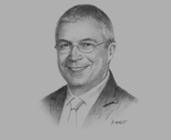OBG talks to Jay Ireland, President and CEO, General Electric Africa

Interview: Jay Ireland
How can international and local firms best capitalise on the US’s Power Africa initiative?
JAY IRELAND: The Power Africa initiative allows the US government to help companies deliver goods and services to the power sector in the six countries covered by this initiative, namely Nigeria, Ghana, Liberia, Kenya, Ethiopia and Tanzania. When you put together a power project, there are a number of issues to deal with. Locally, you have to think about the power purchasing agreement, the fuel source and the contractual arrangements. This typically takes five to seven years, from the initial idea to power on the grid. Two of those years are dedicated to construction, and three to five years are administration and development. Anything we can do to reduce this length of time is key.
There are a number of avenues for financing these projects, but when you go through multiple lenders, they each have different underwriting terms so, to a certain extent, you end up having to deal with the lenders sequentially rather than concurrently. You get an approval from one entity and then you go on to the next one. The US government – in this case the US Agency for International Development and the Export-Import Bank – can help drive some changes in this regard. Another important aspect of Power Africa is that it highlights where the principal opportunities lie for engineering, procurement and construction contractors, power generation companies, transmission and distribution entities, fuel companies, and financial institutions. It’s a programme that highlights a need and then provides a means to execute these projects.
How will Kenya’s grid handle the influx of 5000 MW of additional supply expected under Vision 2030?
IRELAND: The grid’s capacity today is 1500 MW, so it simply must increase. It has to expand and at the same time it has to be strengthened. When you look at Kenya, there are a number of different ways that power can be generated. There is on-grid generation through a number of different sources – geothermal, wind, solar, hydro and thermal. All of these are available in Kenya to differing degrees. You need to have a portfolio of products for on-grid generation, but off-grid solutions also have a role to play. For example, cement plants and sugar factories can power their own operations. This allows us to achieve at least some of the 5000 MW target without actually building out the grid.
What are the main challenges in terms of expanding rural communities’ access to electricity?
IRELAND: There are dense urban areas where a majority of the population lives, and then there is a large rural population that is very spread out. Trying to make it costeffective to get a transmission line out to small villages is a significant challenge.
Therefore, off-grid solutions are key, and they can be done in a number of different ways. One option is biomass, utilising available natural agricultural products and turning them into gas that can power a small engine, which can then in turn provide enough electricity for a small town or also for small solar generation. You have to come up with innovative solutions like these, because it is not going to be economically viable to run a 765-KV line into rural areas.
What alternative methods are available to finance the expansion of Kenya’s transmission networks?
IRELAND: Financing is obviously the key to everything, but there are different ways to go about it. If you consider a power project, you have to go from the fuel to the consumer, which consists of a number of different segments. There has to be an economic return for each link in that chain. If you break it down, the generation piece is the easiest to finance commercially. The hardest part is the transmission and distribution network, and that is where the development banks must contribute, as it involves building out the infrastructure of a country. In the long term, however, Africa is going to have to invest in development through its own pension funds, social security funds and sovereign wealth funds.
You have reached the limit of premium articles you can view for free.
Choose from the options below to purchase print or digital editions of our Reports. You can also purchase a website subscription giving you unlimited access to all of our Reports online for 12 months.
If you have already purchased this Report or have a website subscription, please login to continue.

